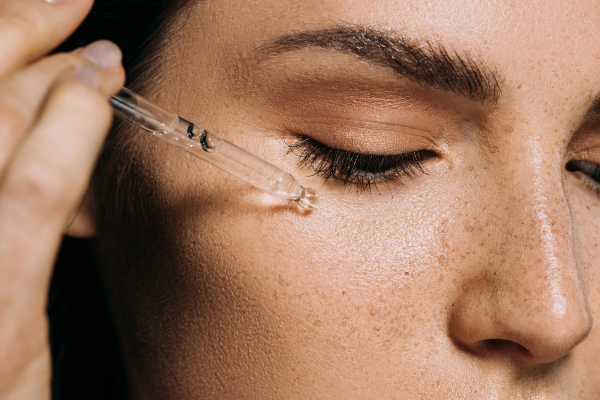Has your skin lost its youthful bounce? Learn why it happens and how you can bring that beautiful bounce back.
If you’ve started to notice your skin looking a little less bright and bouncy and a little more dull and tired lately, then you might be wondering what on earth you’ve done to deserve it. You cleanse, you moisturize, and you do all the things you’ve been told to do. Have the skincare gods forsaken you? Or, is there something you can do to change the trajectory of a deflated complexion?
WHY DOES SKIN LOSE ITS “BOUNCE”?
If your eyes are looking a bit dark, your skin feels dry, and the lines on your face are more noticeable than usual, then obviously you wanna bring back that bounce. First things first: relax. Stressing over it won’t do you any favors. The truth is that your skin can take on a sallow look for a multitude of reasons. Thankfully, there are plenty of hacks you can take advantage of to combat it.
So, why does it happen in the first place? The primary culprit here is usually a lack of hydration, which can be magnified if you’re over 25 due to natural changes related to aging. Over time, our bodies gradually produce less collagen and elastin. By the time women reach menopause, about 30% of collagen supplies are lost. In turn, skin loses the natural moisture that’s usually stored in the fat and muscle tissue, making it look thin.
HOW TO PLUMP UP YOUR SKIN
Tired of deep-set wrinkles, sagging skin, and a sunken appearance? There are ways to bring back some of the lost volume and moisture. Through a combination of lifestyle changes and a little help from science, you can get that bounce back.
-
DIET | Eat more foods with omega 3s and omega 6s. These are skin-loving fatty acids that help strengthen the surface of your skin. Fatty acids help prevent moisture loss, reducing the appearance of wrinkles. You’ll find these omega’s in foods like salmon, mackerel, sardines, olive oil, flax seeds, sunflower seeds, walnuts, almonds, soy, avocados, tofu, and dark leafy greens. Another dietary way to combat dull skin is by making sure you’re getting enough antioxidants. These helpful allies protect your body against oxidative stress and free radical damage. Incorporate more Vitamin C-rich foods like citrus fruits, red peppers, and berries.
-
EXERCISE | Exercise helps boost circulation and stimulate blood flow, nourishing your skin cells with oxygen and other essential nutrients. Not only does this process keeps the skin healthy, but it also promotes collagen production. By increasing your heart rate, you’re also boosting blood flow, helping to regulate blood sugar, and lowering your blood pressure. Try cardio like running, swimming, or cycling. Anything that will make you sweat ticks the box!
-
SLEEP | During sleep, your body releases growth hormones. These hormones repair skin cells, rebuild tissue, and enhance the production of collagen…all while you’re floating away in dreamland. As cell production increases, the natural breakdown of proteins in your body slows down. In other words, good sleep helps protect that precious collagen and elastin, the building blocks of “bouncy” skin.
SKIN PLUMPING ALLIES
Plump, snap-back skin has everything to do with hydration. Skin that holds onto moisture will show fewer fine lines and wrinkles over time, helping you hold onto a more youthful appearance. Science has a few hacks to help you help your skin preserve that oh-so-plump feeling.
-
CERAMIDES | These fats live on the outermost layer of skin, and they’re responsible for keeping our skin firm, protected, and moisturized. Ceramides help our skin cells maintain their structural integrity. If they collapse, our skin sort of sinks inward because there’s not enough of the fatty structure to push it outward. Layers Daily Glow Probiotics contain ceramides to help you rebuild this critical skin structure from the inside out.
-
HYALURONIC ACID | The magic of hyaluronic acid is in its superior ability to hold up to 1,000 times its weight in water. This makes it the perfect skin-plumping ally because it can replace the loss of moisture that happens as we age. It’s sold as a gel-like serum. This is also the stuff that keeps our eyes and joints lubricated.
-
COLLAGEN + ELASTIN | As hyaluronic acid plumps up the spaces between fibers, collagen and elastin are the actual fibers. They form the primary structure of our skin, giving it a stretchy and elastic feel. Eating more Vitamin C-rich foods while simultaneously using hyaluronic acid is a great way to promote the production of collagen and elastin. These foods enhance the ability of the acid to be absorbed, thereby producing more of these vital structural fibers.
We can’t stop the effects of aging, but we can reap the benefits of science to age more gracefully. A healthy lifestyle that incorporates a full spectrum of vitamins, minerals, and antioxidants is always the first step, not only for skin health but for your overall microbiome health. Add skin-specific probiotics and clinically-proven hydrating serums to your scientific bag of tricks and you’ll keep your skin feeling plump and looking youthful. Whether you’ve got 22, 52, or 82 years of wisdom on your side, your skin won’t betray you if you treat it right!








